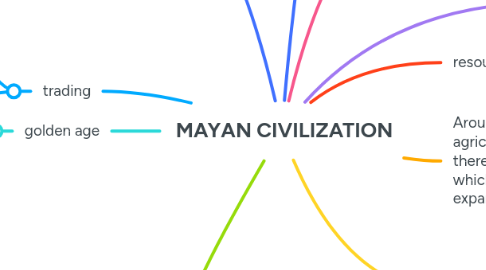MAYAN CIVILIZATION
af Purna Sumanth

1. evolution
1.1. The majority of the evolution of the mayan state was obvious in the prominent and ground-level buildings that were constructed throughout the establishment of these regions.
1.2. For instance, the La Dante Pyramid, which was constructed in the destroyed city of Mirador, was the greatest pyramid in early civilization and in all of ancient Mesoamerica.
2. trading
2.1. Advanced Mayan settlements started engaging in regional trade around 1200 BCE, which brought them into touch with other civilizations, particularly the Olmecs. The Olmecs' gods, cities, rituals, and art were all absorbed by the Mayans.
2.2. pottery
2.2.1. In 1700 BCE, earthenware was created. Trading was made easy by exchanging pots.
3. golden age
3.1. With the fall of El Mirados approximately 150CE, the prominence of the lowland Maya increased. In the lowlands of maya people advanced in art writing and population.
3.2. Calakmul defeated Tikal after a hard battle. Calakmul rose to become the most powerful Mayan state of its time. It was a period of immense cultural and intellectual expansion, particularly in astronomy and the development of the famed Mayan calendar.
3.3. Due to near continual conflict and ecological causes, tikal and calakmul declined throughout the 9th century CE. the end of the Mayan Golden Age
4. MINDMAP
5. Mayan calendar
5.1. Calakmul defeated Tikal after a hard battle. Calamkmul rose to become the most powerful Mayan state of its time. It was a period of immense cultural and intellectual expansion, particularly in astronomy and the development of the famed Mayan calendar.
5.2. many of modern people belived end of mayan calendar leads to end of the world.
6. The Mayan kings discovered they could plunder other tribes for resources, labor, and to drive out rivals. Around 800 BCE, the influence of the lowland Maya spread from riverbanks and land lakes to the interior and central maya, and then it spread to the highland region.
7. rise of mayans
7.1. 40000–20000 BCE saw the rise of the Mayans. People entered North America through Siberia and Alaska. Around 10000 to 80000 BCE, they moved south in quest of a warmer climate, better hunting grounds, and lusher vegetation, and they established in modern-day Mexico's Yucatan peninsula.
8. The early Mayan states were founded in Kaminaljuyu, El Ujuxte, and El Mirador around 400 BCE as a result of their increased state of trade and warfare.
9. resources
9.1. obsidian, jade, fish.
10. Around 6000 BCE, when agriculture began to take hold, there was a huge food surplus, which encouraged population expansion.
11. pre classic period
11.1. The pre-classical period lasted from 1500 BCE to 250 CE. Tribal chiefdoms and early Mayan governments developed during this time from tribal settlements.


